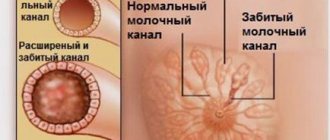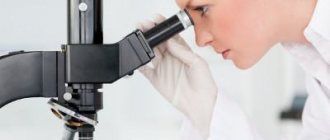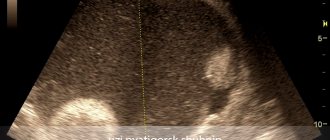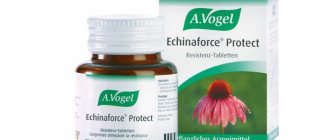Mastitis is an inflammation of the breast tissue. As a result, lumps appear in the chest and it becomes painful. Mastitis is a very unpleasant condition for a nursing mother, but fortunately, there are ways to get rid of it and ease the discomfort. From this article you will learn how the signs of mastitis appear, why it develops and what methods of prevention and treatment are available.
And by the way, don’t forget to read our article “Breastfeeding: 19 tips” - tips from it will help you avoid encountering mastitis.
Signs of lactation mastitis
Often for mothers, the first feedings are quite painful. How to distinguish mastitis from ordinary breast swelling and discomfort? Here are the symptoms of mastitis:
- flu-like state: fever, weakness, chills
- Constant pain in the chest, worsening with feeding
- lump in one breast
- redness on the skin of the chest
- increase in breast volume
- breasts become hot to the touch
- burning sensation when feeding
Mastitis in a nursing mother - symptoms and treatment.
With any form of mastitis, a woman’s body temperature rises and a flu-like syndrome develops, which is caused by intoxication. It could be:
- dizziness and headache;
- pain in muscles and joints, “ache”;
- feeling of chills;
- general weakness and malaise.
The initial stage of mastitis is serous. It is characterized by:
- lack of tightness in the chest;
- maintaining a full flow of milk;
- constant local pain in the mammary gland, which may intensify during feeding;
- slight redness over the area of pain.
- An ultrasound may reveal no changes or slight phenomena of lactostasis.
Then inflammatory edema occurs and mastitis becomes infiltrative. Wherein:
- the general condition of the nursing mother is already more severe;
- flu-like syndrome is pronounced;
- body temperature above 39 C;
- a painful lump is detected in the chest;
- the skin over it is red and hot;
- the outflow of breast milk is impaired (signs of lactostasis).
- On an ultrasound, the doctor already sees a detailed picture of lactostasis and infiltration in the breast tissue.
If at this stage of the disease a woman does not consult a doctor, the body begins to delimit the source of inflammation in order to prevent it from spreading further (otherwise very dangerous conditions may develop: phlegmon, gangrene, sepsis). This is the stage of abscess formation. Its onset can be suspected if a woman notes that she had a high temperature for several days, and it was very bad, and then the temperature returned to normal, and her health improved, the pain became less, but the thickening and redness persisted. The skin over the seal becomes thinner and glossier. Ultrasound reveals a capsule with purulent contents. An abscess is the only form of purulent lactation mastitis that can be treated on an outpatient basis. The rest are subject to inpatient treatment.
Causes of lactation mastitis
There are a number of factors that increase the risk of mastitis:
- Errors in breastfeeding technique.
If the mother does not alternate feeding positions or the breasts do not empty completely, stagnation of milk may form in the milk ducts.
- Clogged ducts.
If milk stagnation occurs, a painful lump appears in the breast. And if the duct is not cleared of milk in time, an infection may develop.
- Cracks or milk blisters on the nipples.
Cracked nipples and blisters can cause infection. A blister on the breast looks like a small white plug next to the nipple; such blisters are also called milk bubbles. A milk bubble is not the same as a chafing on the areola due to improper attachment of the baby. This bladder is filled with milk (or clear serous fluid) and prevents the flow of milk from the nipple.
- Excessive milk production.
- Abrupt cessation of breastfeeding.
- Chest compression.
Wearing a bra that is too tight or squeezing the handle of a heavy bag can interfere with the healthy flow of milk.
- Weakened immunity.
When we are stressed, overworked and/or have a poor diet, our immunity weakens and we become more susceptible to infections, including mastitis.
- Previous mastitis.
- Smoking.
Causes
The cause of purulent mastitis can be prolonged lactostasis and the lack of effective therapy. Most often, the causative agent of infection is Staphylococcus aureus.
Pathogenic microorganisms enter the mammary gland through microcracks in the nipples. Such damage can occur during feeding, when the delicate skin is subjected to severe stress. To minimize the risk of infection, it is necessary to pay special attention to hygiene procedures and prepare nipples for feeding.
The rapid development of the disease is facilitated by an ideal environment for the proliferation of bacteria. If the feeding regime is violated, stagnation of milk, which is saturated with nutrients, may develop. If lactostasis does not go away within three days, there is a high probability of purulent mastitis.
The main reasons contributing to the occurrence of the disease include the following factors:
- incomplete or irregular expression of breast milk;
- congenital changes in the structure of the mammary glands, including thin and tortuous ducts;
- the presence of microcracks in the nipples.
Avoiding purulent mastitis is quite simple. It is necessary to exclude the main causes contributing to the occurrence of inflammation of the mammary gland. It is also recommended to undergo regular medical examination.
When the first signs of lactostasis appear, you need to express milk regularly and immediately make an appointment with a doctor. Compliance with basic rules will preserve the health of the mammary glands and avoid surgical intervention.
It is worth noting that purulent mastitis may not be associated with lactation. These cases are much less common and occur for the following reasons:
- presence of chronic diseases;
- cystic mastopathy;
- mammary gland injuries;
- weakened immune system;
- insufficient hygiene;
- local hypothermia.
In this case, the causative agent may be not only Staphylococcus aureus, but also other pathogenic microorganisms. To determine the nature of the infection and provide the correct treatment, the doctor prescribes laboratory tests.
Treatment of lactation mastitis
For mastitis, your doctor will usually prescribe an antibiotic that is safe for breastfeeding. Improvement is observed within a day or two from the start of taking the medication. But even if the symptoms have passed, be sure to take the entire course of medications prescribed by your doctor.
If you have mastitis, you do not need to interrupt breastfeeding. Inflammation does not affect milk, and regular feedings will help you say goodbye to mastitis faster. Your doctor may also recommend a pain reliever to relieve discomfort. If mastitis does not go away or recurs, see your doctor again.
In addition to the treatment prescribed by your doctor, try the following:
- Drink enough fluids and rest whenever possible.
- Try to empty your breasts completely with each feeding. If breastfeeding is painful, try expressing milk by hand or using a breast pump.
- Do not reduce the frequency of feedings, as this may result in less milk production and mastitis will continue to bother you for a long time. Read our article on how to increase your breast milk supply.
- Try not to skip feedings. If something disrupts your normal “schedule” (for example, you go to work after maternity leave), express milk at about the same time you usually feed your baby.
- Apply a wet or dry warm compress to your breasts before feeding or pumping. You can also take a warm shower or soak your breasts in a sink filled with warm water.
- While your breasts are warm, massage them gently and then feed your baby or express milk. You can also try massaging your breasts with very gentle movements while you feed.
- Go braless in loose tops.
- A popular traditional medicine tip for chest swelling is to apply a cabbage leaf. But the effectiveness of this method has not been confirmed. Hot and cold compresses are more effective in reducing the discomfort of breast engorgement, one of the symptoms of mastitis.
Medical care for purulent mastitis
At the first signs of lactostasis, it is best to immediately consult a doctor and get advice on proper feeding.
Diagnosis of the patient
If mastitis is suspected, the doctor prescribes the following to the woman:
- general blood test and determination of sugar levels;
- Analysis of urine;
- Ultrasound.
Ultrasound diagnostics makes it possible to detect areas of accumulation of pus in tissues, determine their location and size. Under the control of the device, it is convenient to perform a puncture to examine the affected tissues.
We recommend reading more about ultrasound examination of the mammary glands. What diseases can be detected using ultrasound, what advantages does ultrasound examination have in comparison with other methods.
Features of the treatment of purulent mastitis
For lactostasis and at the stage of serous mastitis, conservative treatment is used. Doctors recommend:
- regular expression of milk every 3 hours from healthy and diseased breasts;
- antispasmodics intramuscularly (relieves spasms in the ducts, facilitates pumping);
- antihistamines (provide desensitization);
- antibacterial drugs (kill pathogens);
- UHF therapy;
- compresses, semi-alcohol wraps.
Treatment of purulent mastitis involves surgery. The inflamed tissues are opened under general anesthesia and the lesion is drained.
After the operation, antibacterial therapy is indicated, the abscess cavity is washed with antiseptics (furacillin, chlorhexidine, etc.). If the inflammation has stopped and the milk analysis has confirmed the absence of bacteria in it, you can continue breastfeeding.
If the doctor advises not to put the baby to the breast, this applies even to a healthy gland. In this case, the expressed milk from the inflamed breast must be poured out, and from the healthy breast, it must be given to the baby through a bottle after pasteurization. In some cases, permanent interruption of lactation with the help of medications is indicated.
Non-surgical treatment of purulent mastitis is not effective and can lead to worsening of the condition.
Purulent mastitis: how the operation is performed
The method of performing the operation depends on the characteristics of the disease. The volume of affected tissues and their location determine the choice of surgical approach. Paraareolar incisions for mastitis can be performed in the case of central intramammary and subareolar types. If the mastitis is located in the upper or medial quadrants, a radial Angerer incision is made. You can get to the lateral quadrants along Mostkov (along the outer transitional fold). If the lesion is located in the lower quadrants or total mastitis occurs, a HOGO incision (Hennig approach) is used. However, this method, like the Rovninsky access, does not provide the desired cosmetic effect, and therefore is practically not used.
Is it possible to continue breastfeeding with mastitis?
With mastitis, the infection does not get into the milk, and it cannot harm the baby. And although breastfeeding with mastitis can be painful for mom, try not to stop breastfeeding. The more often the baby suckles at the breast where congestion has occurred, the faster it will be eliminated. You also need to continue feeding to strengthen the baby’s immunity, since breast milk has antibacterial properties.
Rarely, but sometimes breastfeeding with lactation mastitis can be too painful. Then try placing your baby on the healthy breast, and place a cloth or small towel under the breast with mastitis to absorb the dripping milk. Perhaps, after the sore breast is partially emptied, the pressure will decrease and feeding from it will not be so painful. You can also try expressing milk and feeding your baby or saving it for the future.
The discomfort of mastitis can be frustrating and discourage breastfeeding. But with timely treatment, the symptoms of mastitis quickly disappear, and mother and baby can again enjoy the benefits and process of breastfeeding.
How to distinguish lactostasis from mastitis?
Differential diagnosis is the most important point in choosing treatment for mastitis. In order to treat mastitis in a nursing mother, it is necessary to be able to distinguish it from lactostasis.
The main diagnostic sign of mastitis is the development of intoxication and flu-like syndrome, an increase in temperature above 38 C, axillary lymphadenopathy, and severe pain. With lactostasis, the state of health does not change much, since there is no intoxication, and the temperature rises to 38 C.
Prevention of lactation mastitis
Here's what you should do to prevent mastitis:
- Alternate feeding positions to ensure your breasts empty evenly.
- Make sure your baby is latching onto the nipple correctly.
- Let your baby stay at the breast as long as he wants.
- Try not to skip feedings. For example, if you typically feed your baby every two hours, stick to that schedule.
- Before feeding, take a warm shower or place a towel soaked in warm water on your breast. This promotes a freer flow of milk and is useful not only for mastitis.
When you decide to stop breastfeeding and wean your baby, do it gradually. Ask your doctor or lactation consultant for advice.
Treatment
Purulent mastitis in any manifestation requires surgical intervention. The most effective method is a radial incision with removal of purulent inflammation and subsequent drainage. In some cases, it is enough to perform a puncture. It all depends on the results of the examination, the scale of the inflammatory process, the location of the infection and other factors.
The next step is to prescribe a course of antibiotics, which allows you to completely eliminate the inflammatory process and get rid of the causative agent of the infection. After this, the patient undergoes tests, the results of which can be used to judge recovery or plan further therapy.
Treatment of mastitis is a responsible process that requires a professional approach. Therefore, it is worth paying special attention to the choice of clinic and the qualifications of the attending physician.
Treatment methods for mastitis
Treatment is prescribed depending on the form of the disease.
Prevention will help reduce the likelihood of mastitis, including increasing immunity, proper hygiene of the mammary glands during breastfeeding, breastfeeding with mandatory pumping of the mammary glands, and medical examination of women before pregnancy.
For serous form
For the serous form, conservative therapy is used (expressing the mammary glands, local antiseptics, perhaps the use of physiotherapy - UHF, ultrasound).
With infiltrative form
In the infiltrative form, antibiotics are prescribed orally, as well as locally - in the form of novocaine blockades with antibiotics.
With abscess and phlegmonous form
In case of abscess and phlegmonous form, only surgical treatment in a hospital setting is possible.
In gangrenous form
In the case of gangrenous form, the only way out is amputation of the mammary gland.
Make an appointment Do not self-medicate. Contact our specialists who will correctly diagnose and prescribe treatment.
Rate how useful the material was
thank you for rating
Prevention of breast mastitis
To prevent breast mastitis
You should follow the rules of personal hygiene, prevent stagnation of milk and avoid cracks and abrasions on the nipples. Please note that it is necessary to wash the nipple before and after feeding. If we talk about the treatment of cracked breasts, then sea buckthorn oil, white streptocide and starch will help you here.
It is also necessary to remember special rules when breastfeeding
:
- periodically change the position of the child so that the pressure on different parts of the nipple is uniform;
- if after feeding the baby does not let go of the nipple, lightly pinch the baby’s nose so that he pushes the nipple out;
- After feeding, it is recommended to dry the nipple. To do this, he must stay in the air for another 2-3 minutes;
- You should express all remaining milk without touching the nipple with your hands (it is better to use a breast pump);
- change your underwear daily, boil and iron your bra thoroughly.






